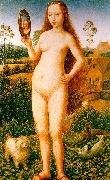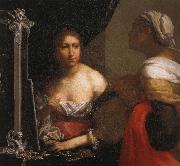Wholesale Oil Painting No Minimum |
|||||||||||
|
|
|||||||||||

|
|||||||||||
|
|
|
||||||||
Hans MemlingNetherlandish Northern Renaissance Painter, ca.1435-1494 Born in Seligenstadt, near Frankfurt in the Middle Rhein region, it is believed that Memling served his apprenticeship at Mainz or Cologne, and later worked in the Netherlands under Rogier van der Weyden (c. 1455?C1460). He then went to Bruges around 1465. There is an apocryphical story that he was a wounded at the Battle of Nancy, sheltered and cured by the Hospitallers at Bruges, and that to show his gratitude he refused payment for a picture he had painted for them. Memling did indeed paint for the Hospitallers, but he painted several pictures for them, in 1479 and 1480, and it is likely that he was known to his patrons of St John, prior to the Battle of Nancy. Memling is connected with military operations only in a distant sense. His name appears on a list of subscribers to the loan which was raised by Maximilian I of Austria, to defend against hostilities towards France in 1480. In 1477, when he was incorrectly claimed to have been killed, he was under contract to create an altarpiece for the gild-chapel of the booksellers of Bruges. This altarpiece, under the name of the Seven Griefs of Mary, is now in the Gallery of Turin. It is one of the fine creations of his more mature period. It is not inferior in any way to those of 1479 in the hospital of St. John, which for their part are hardly less interesting as illustrative of the master's power than The Last Judgment which can be found since the 1470s in the St. Mary's Church, Gda??sk. Critical opinion has been unanimous in assigning this altarpiece to Memling. This affirms that Memling was a resident and a skilled artist at Bruges in 1473; for the Last Judgment was undoubtedly painted and sold to a merchant at Bruges, who shipped it there on board of a vessel bound to the Mediterranean, which was captured by Danzig privateer Paul Beneke in that very year. This purchase of his pictures by an agent of the Medici demonstrates that he had a considerable reputation. |
||||||||
|
|
||||||||
Vanity
Vanity Painting ID:: 2921 |
1485
Musee des Beaux Arts, Strasbourg 1485 Musee des Beaux Arts, Strasbourg |
|||||||
|
|
||||||||
|
|
||||||||
|
|
vanity
vanity Painting ID:: 56379 |
mk247
1904,oil on canvas,51.125x49.25 in,130x125 cm,private collection mk247 1904,oil on canvas,51.125x49.25 in,130x125 cm,private collection |
||||||
|
|
||||||||
FURINI, FrancescoItalian Baroque Era Painter, 1603-1646 Italian painter. He was one of the leading Florentine painters of the first half of the 17th century, famous for the ambiguous sensuality and sfumato effects of his many paintings of female nudes. He first studied with his father, Filippo Furini, nicknamed Pippo Sciamerone and described by Baldinucci as a portrait painter, and he completed his apprenticeship in the studios of Domenico Passignano and of Giovanni Bilivert. Inspired by an admiration for Classical sculpture, which he studied in the Medici collection in Florence, and for Raphael, he travelled to Rome, which he reached as early as 1619 (Gantelli, see 1972 exh. cat.). Here he came into contact with Bartolomeo Manfredi and with Giovanni da San Giovanni. In 1623 he assisted the latter on the frescoes of the Chariot of the Night in the Palazzo Bentivoglio (now Pallavicini-Rospigliosi), commissioned by Cardinal Guido Bentivoglio, and also perhaps on the lower paintings (1623-4) in the apse of the church of SS Quattro Coronati, Rome. |
||||||||
|
|
||||||||
|
|
Vanity
Vanity Painting ID:: 58451 |
mk261 Florence about 1630 oil painting on canvas 83 x 90 cm mk261 Florence about 1630 oil painting on canvas 83 x 90 cm |
||||||
|
|
||||||||
|
FURINI, Francesco Italian Baroque Era Painter, 1603-1646 Italian painter. He was one of the leading Florentine painters of the first half of the 17th century, famous for the ambiguous sensuality and sfumato effects of his many paintings of female nudes. He first studied with his father, Filippo Furini, nicknamed Pippo Sciamerone and described by Baldinucci as a portrait painter, and he completed his apprenticeship in the studios of Domenico Passignano and of Giovanni Bilivert. Inspired by an admiration for Classical sculpture, which he studied in the Medici collection in Florence, and for Raphael, he travelled to Rome, which he reached as early as 1619 (Gantelli, see 1972 exh. cat.). Here he came into contact with Bartolomeo Manfredi and with Giovanni da San Giovanni. In 1623 he assisted the latter on the frescoes of the Chariot of the Night in the Palazzo Bentivoglio (now Pallavicini-Rospigliosi), commissioned by Cardinal Guido Bentivoglio, and also perhaps on the lower paintings (1623-4) in the apse of the church of SS Quattro Coronati, Rome. Vanity mk261 Florence about 1630 oil painting on canvas 83 x 90 cm |
||||||||
|
|
||||||||
|
Prev Next
|
||||||||
|
|
||||||||
|
Related Paintings to FURINI, Francesco :. |
||||||||
|
|
||||||||
|
CONTACT US |



